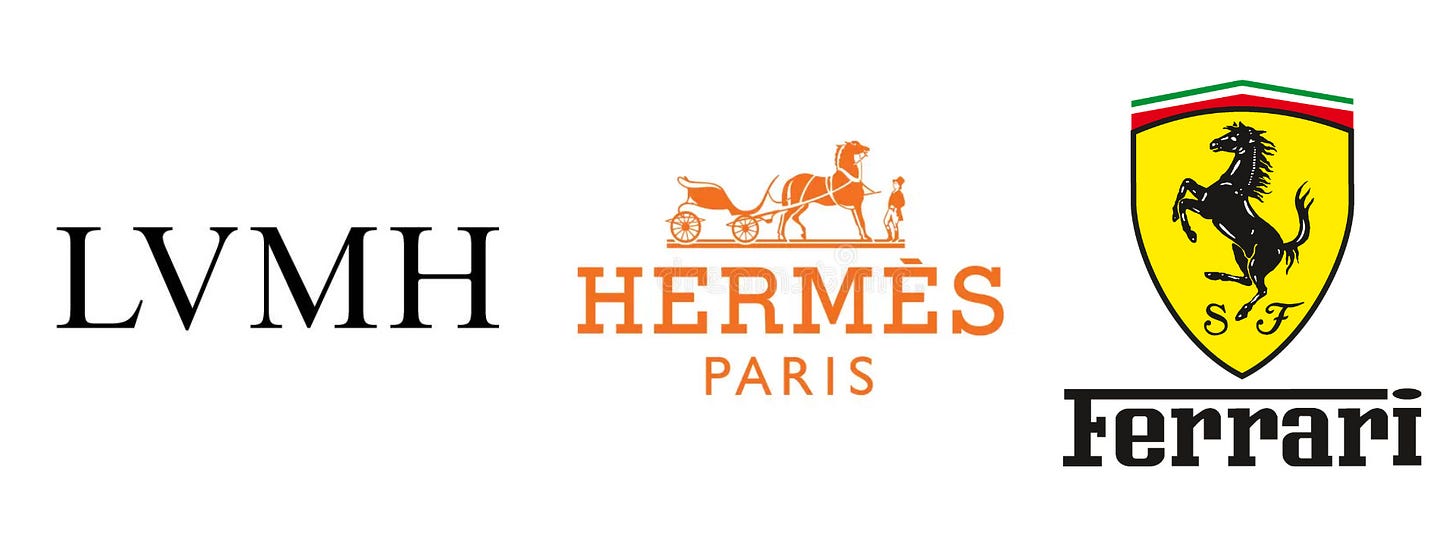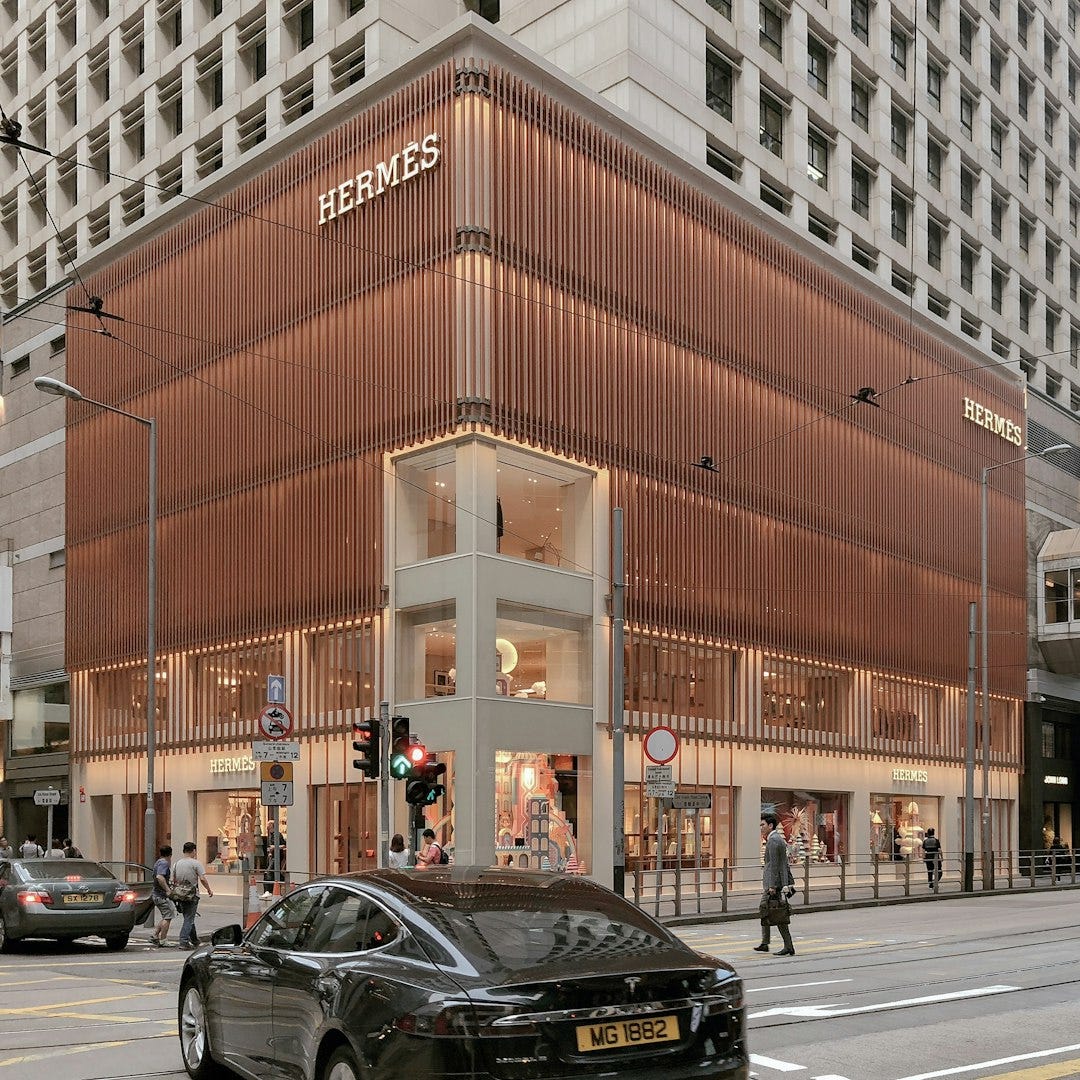The world of luxury is captivating, woven with exquisite craftsmanship, heritage, and exclusivity. At the forefront stand the industry's giants, companies that not only define but constantly reshape the landscape of high-end living. In this article, we delve into the stories and strategies of some of the largest public luxury companies, their brand powerhouses, and the individuals who run them.
The Global Powerhouses:
LVMH (Moët Hennessy Louis Vuitton): A behemoth in the industry, LVMH boasts a staggering $400+ billion market cap and a treasure trove of 75 prestigious brands. From the iconic Louis Vuitton luggage to the exquisite Dior perfumes, LVMH caters to diverse luxury desires. Under the Arnault family's leadership, it emphasizes the long-term growth of each "Maison," preserving their unique identities while fostering synergies within the group.

Hermès: Steeped in history since 1837, Hermès embodies meticulous craftsmanship and exclusivity. With a smaller, but still huge market value of around $225+ billion. With their limited production and sky-high price tags, their legendary Birkin and Kelly bags solidify their position as ultimate status symbols. Family-owned and managed, Hermès prioritizes quality and heritage, maintaining a distinct brand identity within the luxury sphere.
Richemont: This group, with a market cap of $75+ billion, focuses on high-end jewelry, prestigious watches, and premium leather goods. Renowned names like Cartier and Montblanc grace their portfolio, catering to discerning clientele across various luxury segments. Richemont exemplifies the success of conglomerate structures, harnessing the power of diverse brands under one umbrella.
✅ Analyzed for TDI-Premium members
Ferrari: More than just a carmaker, Ferrari is a symbol of automotive excellence and unattainable desire. Their limited-edition, high-performance vehicles command long waiting lists and astronomical prices. Rather than mass production, this strategic focus on exclusivity fuels its brand mystique and elevates its position as the "Hermès of the automotive world."

Kering: Founded in 1963, Kering has become a major player with a $50+ billion market cap. Its portfolio boasts fashion powerhouses like Gucci, Saint Laurent, and Balenciaga, each with a distinct aesthetic and loyal following. The Pinault family plays a key role in steering the company, with François-Henri Pinault as CEO, continuing their legacy in the face of industry rivalries.
✅ Analyzed for TDI-Premium members
Beyond the Big Five:
While the ‘Big Five’ clearly hold substantial power in the luxury industry, their dominance shouldn't overshadow the fascinating stories and contributions of other notable luxury players. Let's venture beyond the established giants and explore some of the ‘smaller’ and ‘less’ known luxury companies:
Moncler: From ski slopes to fashion icons, Moncler blends high-end collaborations with edgy aesthetics, pushing the boundaries of luxury sportswear.
Prada: Timeless design meets playful innovation. Prada's use of unexpected materials like nylon and fur keeps them at the forefront of sophisticated yet fashion-forward luxury.
Brunello Cucinelli: Where ethics meet elegance. This Italian brand crafts luxurious cashmere garments with meticulous detail, prioritizing both sustainability and unparalleled quality.
Capri Holdings: A house of diverse desires. Jimmy Choo's glamour and Versace's boldness offer a range of luxury experiences under one roof.
Burberry: Bridging heritage with a contemporary edge. Burberry seamlessly integrates digital experiences into its stores, keeping its iconic tartan relevant in the modern luxury landscape.
Ermenegildo Zegna: Family-owned tailoring authority. Renowned for luxurious fabrics and impeccable craftsmanship, Zegna caters to gentlemen seeking timeless elegance.
Salvatore Ferragamo: From footwear to full-fledged luxury. Ferragamo's heritage in footwear shines through its designs, while its expansion caters to a wider audience seeking sophisticated Italian style.
These are just a few examples of the many other players that enrich the luxury landscape. Each brand brings its unique story, heritage, and approach to the table, catering to diverse consumer preferences and contributing to the industry's dynamism. As the boundaries of luxury continue to evolve, understanding these diverse players becomes increasingly important to grasp the true essence and future direction of this fascinating world.
Revealing the Secrets:
What sets these companies apart? While strategies differ, some common threads emerge:
Brand Power: Each company meticulously cultivates and protects its brand image (some better than others), emphasizing heritage, craftsmanship, and exclusivity.
Diversification: Many leverage a portfolio of distinct brands, catering to diverse customer segments and preferences.
Leadership: Visionary leaders, often family-driven, steer the companies with long-term perspectives and a deep understanding of the luxury market.
Innovation: While cherishing tradition, these companies embrace innovation in design, materials, and customer experience.
“Where consumers have no prior knowledge of a product, often the price is used as a metric to assess the quality or rather the perception of quality.” - Adriaan Brits
The Allure of Investing in Luxury:
In a world driven by mass production and instant gratification, luxury stands as an antithesis. It offers a promise of exclusivity, quality, and craftsmanship, catering to desires for individuality and timeless elegance. While economic changes may impact other industries, luxury remains relatively unscathed. In fact, during economic downturns, luxury goods can even become more desirable as they are seen as a safe haven for investment.
The true luxury brands, such as Hérmes and Ferrari, are particularly resilient. These companies focus on creating exceptional products that are built to last. They also have a strong understanding of their target market and can create products that appeal to their unique needs and desires. As a result, these brands can command high prices and maintain strong profit margins even during difficult times.
For investors, luxury can be an attractive asset class. It offers the potential for long-term growth and stability. However, it is important to do your research and invest in brands that have a proven track record of success, have excellent management teams, and are considered true luxury.
For who can’t get enough of luxury, TDI-Premium members have access to:
💎 Luxury industry report (in a luxury style of course)
💎 In depth analysis: Kering (incl. audio analysis)
💎 In-depth analysis: Richemont
Have a wonderful day and happy investing.
The Dutch Investors









Arnault has been aggressively buying shares)